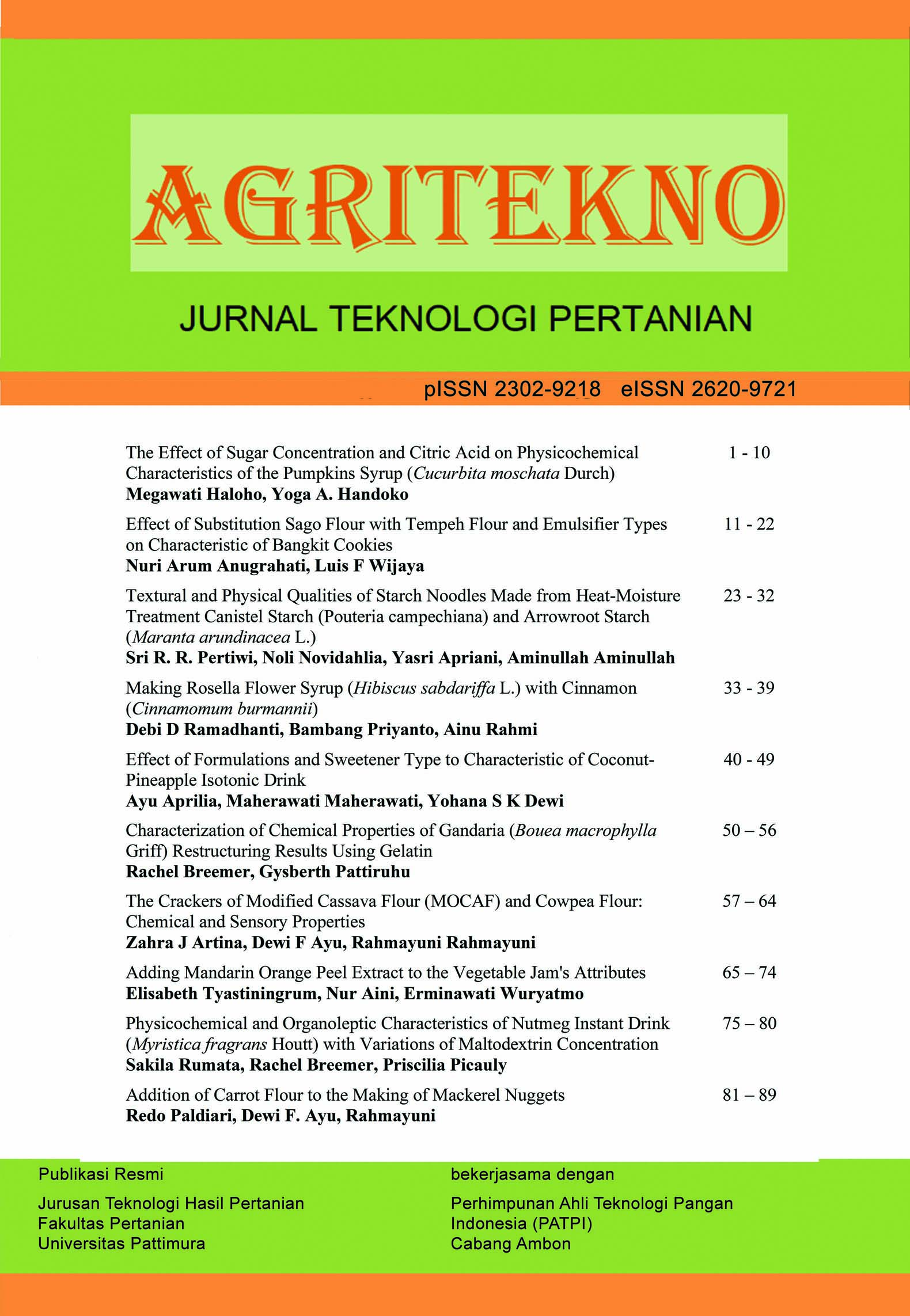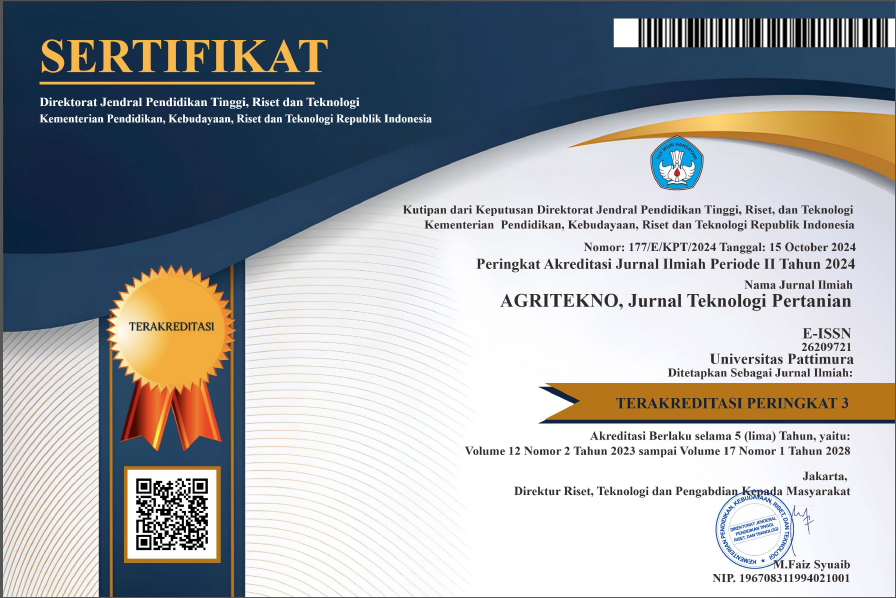Effect of Substitution Sago Flour with Tempeh Flour and Emulsifier Types on Characteristic of Bangkit Cookies
Abstract
Bangkit cookie is a traditional Indonesian cookie that is particularly popular among the Malay people on Sumatra Island, particularly in Riau Province. Bangkit cookies are composed entirely of sago flour, which contains a high carbohydrate but low protein content. Tempeh flour's high protein content is expected to enhance the protein content of the cookies. In addition, the usage of emulsifier will also be expected to improve the texture of the bangkit cookies. This study aimed to determine the best type of tempeh flour for various kinds of beans, i.e., soybeans, green beans, and red beans, based on their highest protein content and to identify the best ratio of tempeh flour to sago flour and the type of emulsifier in the bangkit cookies formula based on their texture and sensory acceptance. This research was divided into two stages. The first research stage used a Completely Randomized Design with 1 factor (soybeans, green beans, and red beans). The second stage of research used a Completely Randomized Design 2 factors (ratio of soybean tempeh flour:sago flour 0:100, 80:20, 60:40, 40:60) and types of emulsifier (egg yolks, soy lecithin, monoglyceride). Research result shows that 80:20, 60:40, and 40:60 ratios of sago flour to soybean tempeh flour with egg yolk emulsifier, soy lecithin, and monoglyceride, increased the protein content by an average of 7.15-21.53% and increased the hardness value of bangkit cookies. The best bangkit cookies are made from the ratio of sago flour and soybean tempeh flour 80:20 with egg yolk emulsifier and meet the SNI of cookies, which have 4.14% of moisture content, 8.95% of protein content, 622.99 hardness, and 3.7 of taste scored which is closest to the control.
Downloads
References
Afrianti, F., Efendi, R., & Yusmarini. (2016). Pemanfaatan pati sagu dan tepung kelapa dalam pembuatan kue bangkit. Jurnal Online Mahasiswa Fakultas Pertanian, 3, 1-16.
AOAC. (2012). Official Methods of Analysis of AOAC International. 19th Edition. Washington DC.
Badan Standardisasi Nasional (BSN). (1992). Biskuit. SNI 01-2973-1992. BSN, Jakarta.
Bastian, F., Ishak, E., Tawali, A.B., & Bilang, M. (2013). Daya terima dan kandungan zat gizi formula tepung tempe dengan penambahan Semi Refined Carrageenan (SRC) dan bubuk kakao. Jurnal Aplikasi Teknologi Pangan, 2, 5-9.
Bhuja, P., Amalo, D., Duan, F.K., & Raharjo, D.S. (2020). The effect of fermentation on protein content and fat content of tempeh gude (Cajanus cajan). Jurnal Biotropikal Sains, 17, 33-41.
Efendi, R., Herawati, N., & Sari, S.M. (2015). Evaluasi mutu kue bangkit dengan bahan dasar kombinasi tepung sagu, tepung tempe, dan tepung ubi jalar. Prosiding Seminar Agroindustri dan Lokakarya Nasional FKPT-TPI. 2-3 September 2015, Riau, Indonesia. pp. 212-215.
Fereidoon, S., Szuhaj, B.F., & Yeo, J.D. (2020). Bailey’s Industrial Oil dan Fat Products 7th Edition. Wiley-Interscience. New Jersey.
Jariyah, Yektiningsih, E., Sarofa, U., & Sopade, P.A. (2018). Effect of partial replacement of wheat flour with various mangrove fruit floursand different emulsifiers on physicochemical properties of biscuits. Indonesian Journal of Agricultural Research, 1, 152-161. https://doi.org/10.32734/injar.v1i2.318
Jauhari, M., Sulaeman, A., Riyadi, H., & Ekayanti, I. (2014). Pengembangan formula minuman olahraga berbasis tempe untuk pemulihan kerusakan otot. Agritech, 34, 285-291. https://doi.org/10.22146/agritech.9456
Juliandri. (2017). Analisis kelayakan usaha makanan tradisional kue bangkit di Kota Pekanbaru. Jurnal Online Mahasiswa Fakultas Ekonomi, 4, 1121-1134.
Maryam, S. (2015). Komponen gizi tempe kacang hijau (Vigna radiata L.) hasil proses fermentasi menggunakan inokulum serbuk. Seminar Nasional Riset Inovatif III(3), 454-459.
Molnar, D., Brncic, S.R., Vujic, L., Gyimes, E., & Krisch, J. (2015). Characterization of biscuits enriched with back currant and jostaberry powder. Croation Journal of Food Technology, Biotechnology and Nutrition, 10, 31-36.
Nurani, S., & Yuwono, S.S. (2014). Pemanfaatan tepung kimpul (Xanthosoma sagititifolium) sebagian bahan baku cookies (Kajian proporsi tepung dan penambahan margarin). Jurnal Pangan dan Agroindustri, 2, 50-58.
Radiati, A., & Sumarto. (2016). Analisis sifat fisik, sifat organoleptik, dan kandungan gizi pada produk tempe dari kacang non kedelai. Jurnal Aplikasi Teknologi Pangan, 5, 16-2. http://dx.doi.org/10.17728/jatp.v5i1.32
Rimbawan, Utaru, D.M., Riyadi, H., Muhilal, & Purwantyastuti. (2011). Potensi asam amino pada tempe untuk memperbaiki profil lipid dan diabetes mellitus. Jurnal Kesehatan Masyarakat, 5, 164-172. http://dx.doi.org/10.21109/kesmas.v5i4.137
Ruben, E., Wisaniyasa, N.W., & Pratiwi, I.D.P. (2016). Studi sifat fisik, kimia, dan fungsional tepung kacang merah dan tepung tempe kacang merah (Phaseolus vulgaris L.). Jurnal Ilmu dan Teknologi Pangan, 5, 1-11.
Sari, S., Efendi, R., & Herawati, N. (2016). Karakteristik fisikokimia dan sensori kue bangkit berbahan pati sagu, tepung tempe, dan tepung ubi jalar ungu. Sagu, 15, 18-27.
Seveline, Diana, N., & Taufik, M. (2019). Formulasi cookies dengan fortifikasi tepung tempe dengan penambahan rosela (Hibiscus sabdariffa L.). Jurnal Bioindustri, 1, 245-261. https://doi.org/10.31326/jbio.v1i2.78
Sine, Y., & Soetarto, E. (2016). Kandungan asam amino pada tempe gude. Prosiding Symbion FKIP. 27 Agustus 2016, Yogyakarta, Indonesia. pp. 429-435.
Syahrial, Hamzah, F., & Herawati, N. (2016). Pemanfaatan tepung tempe pada pembuatan kerupuk sagu. Jurnal Fakultas Pertanian, 3, 1-15.
Szkudzińska, K., Smuntniak, I., Rubaj, J., Korol, W., & Bielecka, G. (2017). Method validation for determination of amino acids in feed by UPLC. Accreditation and Quality Assurance, 22, 247-252.
Tamba, A., Ginting, S., & Limbong, L.N. (2014). Pengaruh substitusi tepung labu kuning pada tepung terigu dan konsentrasi ragi pada pembuatan donat. Jurnal Rekayasa Pangan dan Pertanian, 2, 117-124.
Wang, J. McDowell, D.J., Hahm, T.S., & Lo, Y.M. (2007). Effects of expanded polytetrafluoroethylene as a packaging material on the appearance and texture of microwave-baked soy cookies. International Journal of Food Properties, 11, 427-438. https://doi.org/10.1080/10942910701530818
Widiantara, T., Arief, D.Z., & Yuniar, E. (2018). Kajian perbandingan tepung kacang koro pedang (Canavalia ensiformis) dengan tepung tapioka dan konsentrasi kuning telur terhadap karakteristik cookies koro. Pasundan Food Technology Journal, 5, 146-154. https://doi.org/10.23969/pftj.v5i2.1045
Yan, B., Park, S.H., & Balasuramaniam, V.M. (2017). Influence of high pressure homogenization with and without lecithin on particle size and physicochemical properties of whey protein-based emulsions. Journal of Food Process Engineering, 40, 1-10. https://doi.org/10.1111/jfpe.12578
Copyright (c) 2023 The Author(s)

This work is licensed under a Creative Commons Attribution-ShareAlike 4.0 International License.
Authors who publish with this journal agree to the following terms:
- Authors retain copyright and grant the journal the right of first publication with the work simultaneously licensed under a Creative Commons Attribution License that allows others to share the work with an acknowledgement of the work's authorship and initial publication in this journal.
- Authors are able to enter into separate, additional contractual arrangements for the non-exclusive distribution of the journal's published version of the work (e.g., post it to an institutional repository or publish it in a book), with an acknowledgement of its initial publication in this journal.
- Authors are permitted and encouraged to post their work online (e.g., in institutional repositories or on their website) prior to and during the submission process, as it can lead to productive exchanges, as well as earlier and greater citation of published work (See The Effect of Open Access).









